
Plusiinae is a smallish subfamily of the moth family Noctuidae. As the Noctuidae appear to be a paraphyletic assemblage, the Plusiinae may eventually be raised to family status.

Syngrapha is a genus of moths of the family Noctuidae.

Syngrapha ain is a moth of the family Noctuidae.

Syngrapha rectangula, the salt and pepper looper or angulated cutworm, is a moth of the family Noctuidae. The species was first described by William Kirby in 1837. It is found in North America from Newfoundland, Quebec, northern Ontario to Manitoba, New Jersey, northern Pennsylvania, southern Michigan, northern Wisconsin, North Carolina, Virginia, British Columbia, Alberta, Montana, northern Idaho and the Cascades.

Syngrapha abstrusa, the abstruse false looper, is a moth of the family Noctuidae. The species was first described by Thomas D. Eichlin and Hugh B. Cunningham in 1978. It is found in North America from Newfoundland to New Jersey, southern Canada, Montana and northern New Mexico.
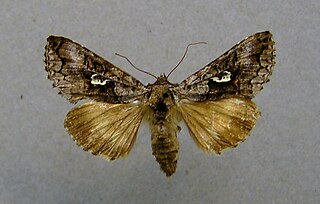
Syngrapha interrogationis, the scarce silver Y, is a moth of the family Noctuidae. It is found in northern part of the world including Alaska, Canada, Iceland, Europe, Siberia, the Pacific Northwest region of the United States, and Northeast Asia.

Syngrapha altera is a moth of the family Noctuidae. It is found from Newfoundland to Manitoba and Northern Michigan.

Euxoa recussa is a moth of the family Noctuidae. The nominate form is found in mountainous areas in Southern Europe as well as the Alps. Euxoa recussa tetrastigma is found Northern Europe, east to Russia, Western Siberia, the Altai Mountains and Amur.
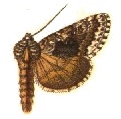
Syngrapha u-aureum, the golden looper moth, is a moth of the family Noctuidae. It is found from eastern Manitoba to Quebec, Labrador, southern Greenland, Newfoundland, northern Maine, northern New Hampshire and northern New York.
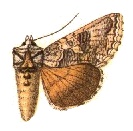
Syngrapha selecta, the chosen looper moth, is a moth of the family Noctuidae. The species was first described by Francis Walker in 1858. It is found in North America from the Northwest Territories to Newfoundland south to northern Michigan.
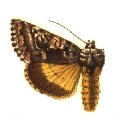
Syngrapha octoscripta, the figure-eight looper moth or dusky silver Y, is a moth of the family Noctuidae. The species was first described by Augustus Radcliffe Grote in 1874. It is found in North America from coast to coast in most of Canada south in the east to northern Pennsylvania, Ohio, and the Great Lakes states.

Syngrapha microgamma, the little bride looper moth, is a moth of the family Noctuidae. The species was first described by Jacob Hübner in 1823. It is found in much of Canada south in the east to southern Maine, northern New York, and the Great Lakes states. In Europe, it is found from Fennoscandia and central Europe east to mountains eastern Asia.

Syngrapha epigaea, the pirate looper moth or narrow silver Y, is a moth of the family Noctuidae. The species was first described by Augustus Radcliffe Grote in 1874. It is found from coast to coast in Canada south in the east to Pennsylvania, Ohio, and the northern Great Lakes states.
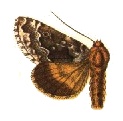
Syngrapha angulidens is a moth of the family Noctuidae first described by Smith in 1891. It is found from Alaska south in the mountains to northern Oregon, western Nevada, Arizona and New Mexico and east to Colorado, western Wyoming, Montana and Alberta.

Syngrapha alticola, the alticola looper moth or alpine beauty, is a moth of the family Noctuidae. The species was first described by Francis Walker in 1858. It is found across the Arctic of North America, above the treeline from Newfoundland to Alaska, south in the mountains to central California and Colorado.
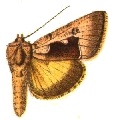
Syngrapha diasema is a moth of the family Noctuidae first described by Jean Baptiste Boisduval in 1829. It is found from northern Fennoscandia to Siberia, across the Arctic and subarctic. In North America, it has been reported across the Arctic and subarctic from Labrador to central Alaska.
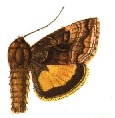
Syngrapha ignea, the mountain beauty, is a moth of the family Noctuidae. The species was first described by Augustus Radcliffe Grote in 1864. It is found from northern Alaska south to southern California and New Mexico, with a disjunct population in Labrador. It is also found sparingly across the boreal forest and the subarctic.
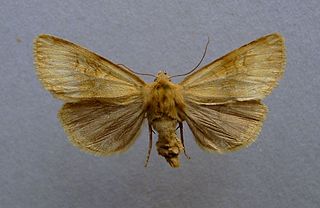
Xestia lorezi is a moth of the family Noctuidae. It is found in northern Europe and the Alps. Subspecies lorezi is found in the Alps on altitudes between 1,700 and 2,500 meters. Subspecies kongsvoldensis is found in Fennoscandia and northern Russia. Outside of Europe, there are four more subspecies, ssp. sajana in the Sayan Mountains, ssp. katuna in the Altai Mountains, ssp. monotona in Yakutia and ssp. ogilviana in Yukon and Alaska.

Xestia rhaetica is a moth of the family Noctuidae. It is found in northern Europe, central Fennoscandia, northern Russia and further east to Siberia. It is also present in the Tatra Mountains and the Bohemian Forest. In the Alps it is found on altitudes between 1,000 and 2,500 meters, but it is found at sea level in northern Europe. The species is also present in the Nearctic, including New York.

Syngrapha devergens is a moth of the family Noctuidae. It is found in the Alps, the Tian Shan Mountains and the Altai Mountains



















